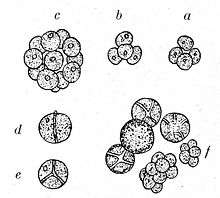Chlorella autotrophica
Chlorella autotrophica, or Chlorella sp. (580), is a euryhaline, unicellular microalgae found in brackish waters first isolated in 1956 by Ralph A. Lewin.[1] The species is defined by its inability to use organic carbon as a food source, making the species an obligate autotroph.[2] It is sometimes considered a variety of Chlorella vulgaris.[3]
| Chlorella autotrophica | |
|---|---|
 | |
| Scientific classification | |
| Phylum: | Chlorophyta |
| Class: | Trebouxiophyceae |
| Order: | Chlorellales |
| Family: | Chlorellaceae |
| Genus: | Chlorella |
| Species: | C. autotrophica |
| Binomial name | |
| Chlorella autotrophica Shihira & R.W.Krauss | |
Uses
C. autotrophica has many uses. The species has been used as a feedstock for rearing bivalves and fry in aquaculture[4] and as source of the amino acid L-Proline.[5][6] German and Russian scientists investigated the possibility of using the species as a food source for astronauts.[7][8] The algal species is also a candidate feedstock for biodiesel production due to its ability to accumulate triglycerides under nitrogen limitation.
References
- Lewin, Ralph (1956). "Extracellular polysaccharides of green algae". Canadian Journal of Microbiology. 7 (2): 665–672. doi:10.1139/m56-079.
- Krauss, Robert W; Shihira, Ikurio (1965). Chlorella: Physiology and taxonomy of forty-one isolates. University of Maryland. Retrieved 28 June 2014.
- "Algaebase". Retrieved 30 June 2014.
- Ukeles, Ravenna. "A simple method for the mass culture of marine algae" (PDF). ASLO Publications. Association for the Sciences of Limnology and Oceanography. Archived from the original (PDF) on 23 September 2015. Retrieved 29 June 2014.
- Leavitt, Richard I. "Process for the preparation of L-proline by cultivating algae". Google Patents. Ethyl Corporation. Retrieved 29 June 2014.
- Hellebust, JA; Ahmad, I (1984). "Nitrogen Metabolism of the Marine Microalga Chlorella autotrophica". Plant Physiology. 76 (3): 658–663. doi:10.1104/pp.76.3.658. PMC 1064351. PMID 16663902.
- Kondratiev, Y; Bychkov, V; Ushakov, A; Boiko, N; Klyushkina, N; Abaturova, E; Terpilovsky, A; Korneeva, N; Belyakova, M; Kasatkina, A (1966). "The use of 50 and 100 g of dry biological foodstuff containing unicellular algae in food rations of man". Voprosy Pitanya. 25 (6): 9–14. PMID 6002339.
- Müller-Wecker, Hildegard; Kofrányi, Ernst (1973). "Zur Bestimmung der biologischen Wertigkeit von Nahrungsproteinen, XVIII. Einzeller als zusätzliche Nahrungsquelle". Hoppe-Seyler's Zeitschrift für physiologische Chemie. 354 (2): 1034–1042. doi:10.1515/bchm2.1973.354.2.1034.